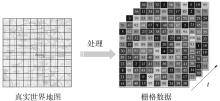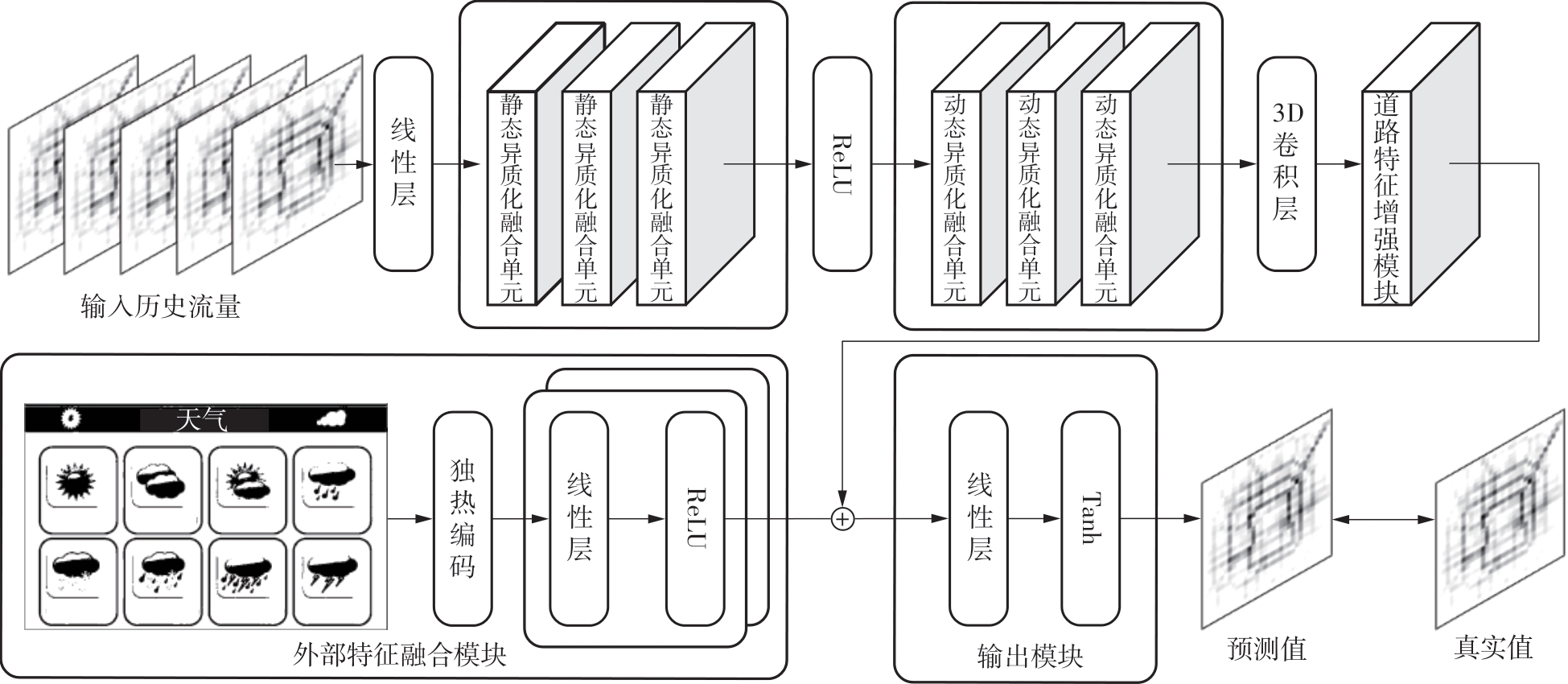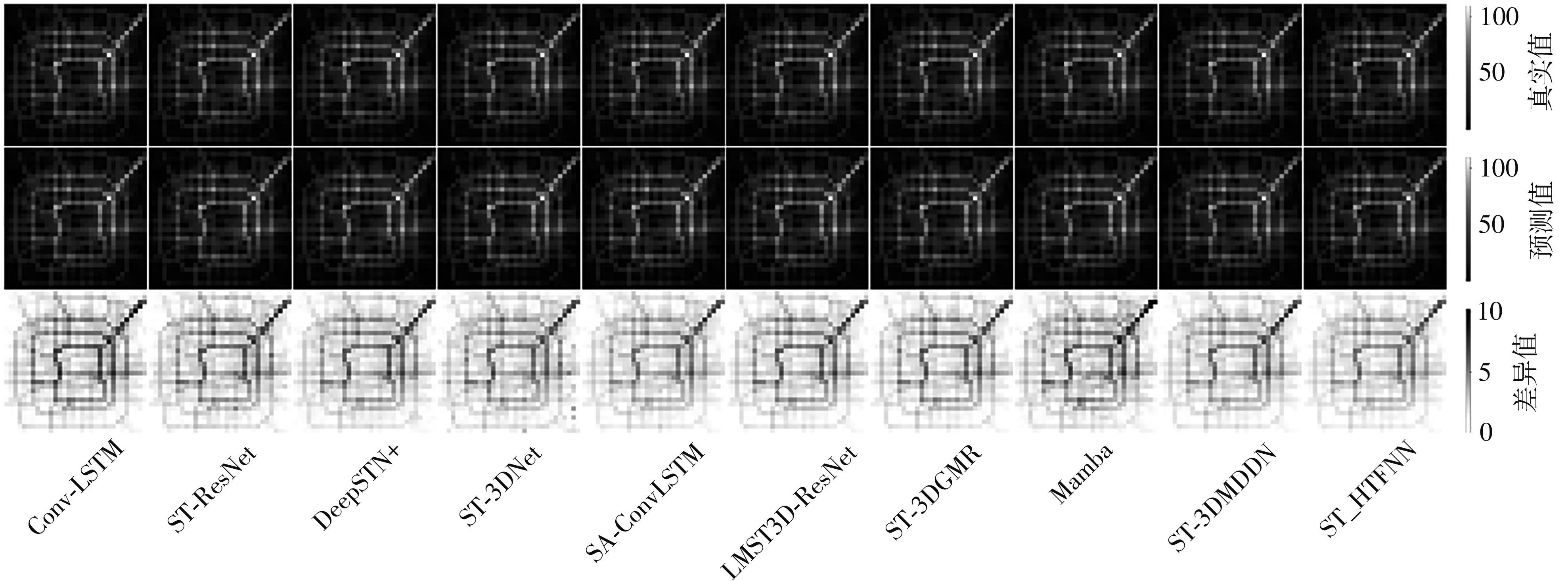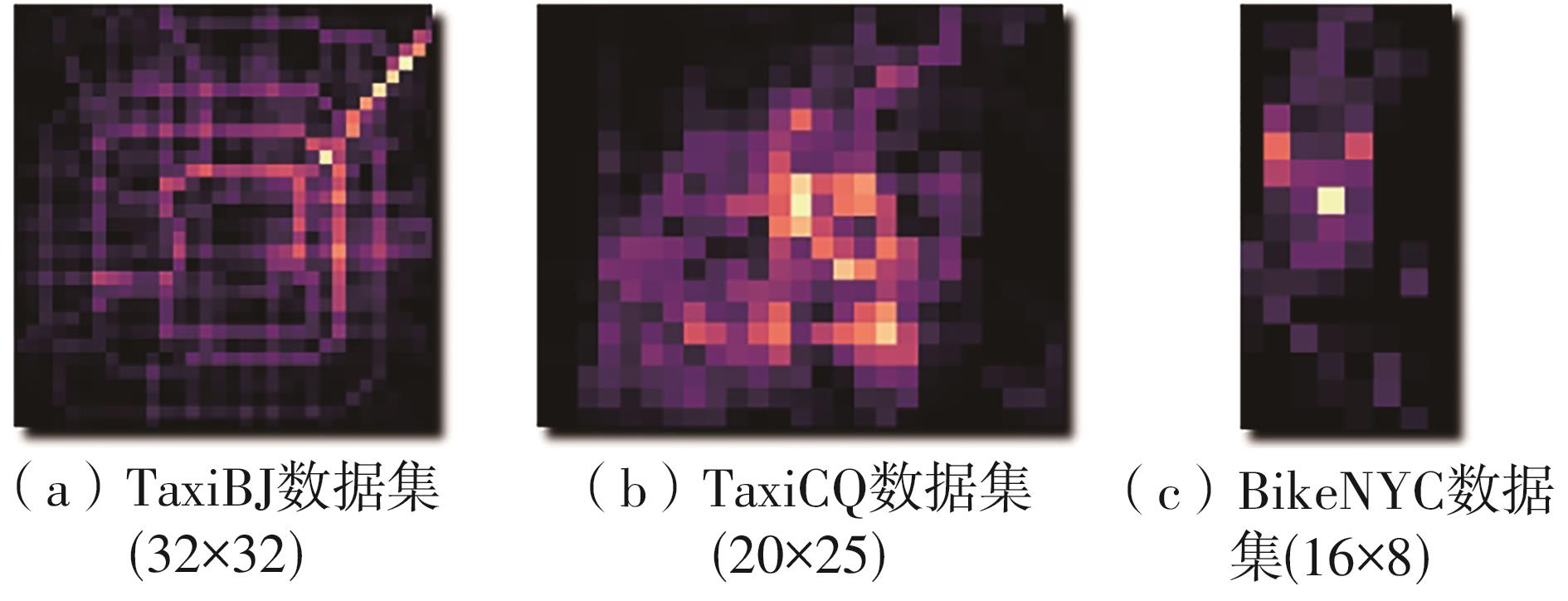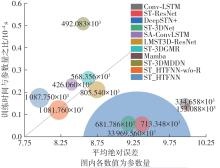Journal of South China University of Technology(Natural Science Edition) ›› 2025, Vol. 53 ›› Issue (5): 82-93.doi: 10.12141/j.issn.1000-565X.240480
• Computer Science & Technology • Previous Articles Next Articles
A Spatiotemporal Heterogeneous Two-Stage Fusion Network for Traffic Flow Prediction
HOU Yue, YIN Jie, ZHANG Zhihao, LU Keke
- School of Electronics and Information Engineering,Lanzhou Jiaotong University,Lanzhou 730070,Gansu,China
-
Received:2024-09-26Online:2025-05-25Published:2024-12-04 -
About author:侯越(1979—),女,博士,教授,主要从事大数据挖掘、智能交通等研究。E-mail: houyue@mail.lzjtu.cn -
Supported by:the National Natural Science Foundation of China(62063014);the Natural Science Foundation of Gansu Province(22JR5RA365)
CLC Number:
Cite this article
HOU Yue, YIN Jie, ZHANG Zhihao, LU Keke. A Spatiotemporal Heterogeneous Two-Stage Fusion Network for Traffic Flow Prediction[J]. Journal of South China University of Technology(Natural Science Edition), 2025, 53(5): 82-93.
share this article
Table 2
Metrics values of various models on TaxiBJ dataset"
| 模型 | MSE | MAE | SSIM | PSNR |
|---|---|---|---|---|
| HA | 3.146 3 | 33.918 0 | 0.747 8 | 31.923 8 |
| ARIMA | 2.047 4 | 25.216 9 | 0.849 9 | 33.352 2 |
| Conv-LSTM | 0.303 7 | 9.963 0 | 0.966 9 | 37.964 1 |
| ST-ResNet | 0.248 2 | 9.366 3 | 0.967 8 | 38.386 4 |
| DeepSTN+ | 0.237 4 | 9.269 6 | 0.969 9 | 38.637 6 |
| ST-3DNet | 0.235 3 | 9.181 6 | 0.970 9 | 38.501 1 |
| SA-ConvLSTM | 0.212 2 | 8.396 8 | 0.976 5 | 39.314 8 |
| LMST3D-ResNet | 0.228 0 | 8.744 8 | 0.971 7 | 38.949 6 |
| ST-3DGMR | 0.228 2 | 8.629 2 | 0.973 1 | 39.039 7 |
| Mamba | 0.268 5 | 9.989 9 | 0.965 9 | 37.830 0 |
| ST-3DMDDN | 0.214 4 | 8.556 9 | 0.976 5 | 39.215 4 |
| ST_HTFNN | 0.199 7 | 7.957 0 | 0.977 3 | 39.682 1 |
Table 3
Training conditions for each model"
| 模型 | MAE | 每轮训练时间/s | 参数量/103 |
|---|---|---|---|
| Conv-LSTM | 9.963 0 | 5 | 334.658 |
| ST-ResNet | 9.366 3 | 4 | 713.348 |
| DeepSTN+ | 9.269 6 | 9 | 33 969.560 |
| ST-3DNet | 9.181 6 | 4 | 681.786 |
| SA-ConvLSTM | 8.396 8 | 10 | 426.060 |
| LMST3D-ResNet | 8.744 8 | 17 | 805.540 |
| ST-3DGMR | 8.629 2 | 15 | 568.356 |
| Mamba | 9.989 9 | 2 | 153.088 |
| ST-3DMDDN | 8.556 9 | 25 | 492.083 |
| ST_HTFNN-w/o-S | 8.220 4 | 13 | 1 081.760 |
| ST_HTFNN | 7.957 0 | 19 | 1 087.750 |
| 1 | JILANI U, ASIF M, ZIA M Y I,et al .A systematic review on urban road traffic congestion[J].Wireless Personal Communications,2023,140 1-29. |
| 2 | ZHANG Y, LI X, WANG H .Urbanization and traffic congestion:challenges and solutions for sustainable urban mobility[J].Sustainable Cities and Society,2021,75:103098/1-14. |
| 3 | 秦严严 .交通流分析理论[M].北京:人民交通出版社,2023:1-4. |
| 4 | CHEN B, CHEN Y, WU Y,et al .The effects of autonomous vehicles on traffic efficiency and energy consumption[J].Systems,2023,11(7):347/1-23. |
| 5 | 潘理虎,尹佳莉,张睿,等 .面向交通流预测的全局‒局部时空感知模型[J/OL].计算机工程,2024.Doi: 10.19678/j.issn.1000-3428.0069550. |
| PAN Lihu, YIN Jiali, ZHANG Rui,et al .Global-local spatio-temporal perception model for traffic flow prediction[J/OL].Computer Engineering,2024.Doi: 10.19678/j.issn.1000-3428.0069550. | |
| 6 | 崔建勋,要甲,赵泊媛 .基于深度学习的短期交通流预测方法综述[J].交通运输工程学报,2024,24(2):50-64. |
| CUI Jian-xun, YAO Jia, ZHAO Bo-yuan .Review on short-term traffic flow prediction methods based on deep learning[J].Journal of Traffic and Transportation Engineering,2024,24(2):50-64. | |
| 7 | MEDINA-SALGADO B, SÁNCHEZ-DELACRUZ E, POZOS-PARRA P,et al .Urban traffic flow prediction techniques:a review[J].Sustainable Computing:Informatics and Systems,2022,35:100739/1-16. |
| 8 | WILLIAMS B M, HOEL L A .Modeling and forecasting vehicular traffic flow as a seasonal ARIMA process:theoretical basis and empirical results[J].Journal of Transportation Engineering,2003,129(6):664-672. |
| 9 | KUMAR S V, VANAJAKSHI L .Short-term traffic flow prediction using seasonal ARIMA model with limited input data[J].European Transport Research Review,2015,7:1-9. |
| 10 | LUO X, LI D, ZHANG S .Traffic flow prediction during the holidays based on DFT and SVR[J].Journal of Sensors,2019,2019(1):6461450/1-10. |
| 11 | CORTES C, VAPNIK V .Support-vector networks[J].Machine Learning,1995,20(3):273-297. |
| 12 | BREIMAN L .Random forests[J].Machine Learning,2001,45:5-32. |
| 13 | LUO C, HUANG C, CAO J,et al .Short-term traffic flow prediction based on least square support vector machine with hybrid optimization algorithm[J].Neural Processing Letters,2019,50:2305-2322. |
| 14 | ZAREI N, GHAYOUR M A, HASHEMI S .Road tra-ffic prediction using context-aware random forest based on volatility nature of traffic flows[C]∥Proceedings of the 5th Asian Conference on Intelligent Information and Database Systems.Kuala Lumpur:Springer Berlin Heidelberg,2013:196-205. |
| 15 | HINTON G E, SALAKHUTDINOV R R .Reducing the dimensionality of data with neural networks[J].Science,2006,313(5786):504-507. |
| 16 | MEDSKER L R, JAIN L .Recurrent neural networks:design and applications[M].[S.l.]:CRC Press,1999. |
| 17 | HOCHREITER S, SCHMIDHUBER J .Long short-term memory[J].Neural Computation,1997,9(8):1735-1780. |
| 18 | LIU Y, ZHENG H, FENG X,et al .Short-term tra-ffic flow prediction with Conv-LSTM[C]∥Proceedings of 2017 9th International Conference on Wireless Communications and Signal Processing.Nanjing:IEEE,2017:1-6. |
| 19 | ZHANG J, ZHENG Y, QI D .Deep spatio-temporal residual networks for citywide crowd flows prediction[C]∥Proceedings of the AAAI Conference on Artificial Intelligence.San Francisco:AAAI Press,2017:1655-1661. |
| 20 | HE K, ZHANG X, REN S,et al .Deep residual learning for image recognition[C]∥Proceedings of the IEEE Conference on Computer Vision and Pattern Re-cognition.Las Vegas:IEEE Computer Society,2016:770-778. |
| 21 | LIN Z, FENG J, LU Z,et al .DeepSTN+:context-aware spatial-temporal neural network for crowd flow prediction in metropolis[C]∥Proceedings of the AAAI Conference on Artificial Intelligence.Hawaii:AAAI Press,2019:1020-1027. |
| 22 | LIN Z, LI M, ZHENG Z,et al .Self-attention Conv-LSTM for spatiotemporal prediction[C]∥Proceedings of the AAAI Conference on Artificial Intelligence.New York:AAAI Press,2020:11531-11538. |
| 23 | GUO S, LIN Y, LI S,et al .Deep spatial-temporal 3D convolutional neural networks for traffic data forecasting[J].IEEE Transactions on Intelligent Transportation Systems,2019,20(10):3913-3926. |
| 24 | HE R, ZHANG C, XIAO Y,et al .Deep spatio-temporal 3D dilated dense neural network for traffic flow prediction[J].Expert Systems with Applications,2024,237:121394. |
| 25 | GU A,DAO T .Mamba:linear-time sequence modeling with selective state spaces[EB/OL].(2023-12-01)[2024-09-20].. |
| 26 | HAN D, WANG Z, XIA Z,et al .Demystify Mamba in vision:a linear attention perspective[EB/OL].(2024-05-26)[2024-09-20].. |
| 27 | YU F .Multi-scale context aggregation by dilated convolutions[EB/OL].(2014-07-07)[2024-09-20].. |
| 28 | CHOLLET F .Xception:deep learning with depthwise separable convolutions[C]∥Proceedings of the IEEE Conference on Computer Vision and Pattern Recognition.Honolulu:IEEE Computer Society,2017:1251-1258. |
| 29 | LU Z, LI J, LIU H,et al .Transformer for single-image super-resolution[C]∥Proceedings of the IEEE/CVF Conference on Computer Vision and Pattern Recognition.New York:IEEE,2022:457-466. |
| 30 | VASWANI A .Attention is all you need[J].Advances in Neural Information Processing Systems,2017,30:5998-6008. |
| 31 | LIU Z, MAO H, WU C Y,et al .A convnet for the 2020s[C]∥Proceedings of the IEEE/CVF Conference on Computer Vision and Pattern Recognition.Honolulu:IEEE Computer Society,2022:11976-11986. |
| 32 | 于政 .基于深度学习的文本向量化研究与应用[D].上海:华东师范大学,2016. |
| 33 | HE R, LIU Y, XIAO Y,et al .Deep spatio-temporal 3D densenet with multiscale ConvLSTM-Resnet network for citywide traffic flow forecasting[J].Knowledge-Based Systems,2022,250(C):109054/1-17. |
| 34 | KINGMA D, BA J .Adam:a method for stochastic optimization[J].Computer Science,2014.Doi:10.48550/arXiv.1412.6980. |
| 35 | CHEN Y, ZOU X, LI K,et al .Multiple local 3D CNNs for region-based prediction in smart cities[J].Information Sciences,2021,542:476-491. |
| 36 | HE R, XIAO Y, LU X,et al .ST-3DGMR:spatio-temporal 3D grouped multiscale ResNet network for region-based urban traffic flow prediction[J].Information Sciences,2023,624:68-93. |
| 37 | WANG Z, BOVIK A C, SHEIKH H R,et al .Image quality assessment:from error visibility to structural similarity[J].IEEE transactions on Image Processing,2004,13(4):600-612. |
| 38 | HORE A, ZIOU D .Image quality metrics:PSNR vs. SSIM[C]∥Proceedings of 2010 20th International Conference on Pattern Recognition.Piscataway:IEEE,2010:2366-2369. |
| [1] | ZHOU Chuhao, LIN Peiqun, YAN Mingyue. Traffic Data Imputation Based on Self-Supervised Learning [J]. Journal of South China University of Technology(Natural Science Edition), 2023, 51(4): 101-114. |
| [2] | YANG Jinsheng, CHEN Hongpeng, GUAN Xin, et al. A Multi-Scale Lightweight Brain Glioma Image Segmentation Network [J]. Journal of South China University of Technology(Natural Science Edition), 2022, 50(12): 132-141. |
| [3] | YI Qingming, LÜ Renyi, SHI Min, et al. Lightweight Object Detection Combined with Multi-Scale Dilated-Convolution and Multi-Scale Deconvolution [J]. Journal of South China University of Technology(Natural Science Edition), 2022, 50(12): 41-48. |
| [4] | YUAN Hua CHEN Zehao. Short-term Traffic Flow Prediction Based on Temporal Convolutional Networks [J]. Journal of South China University of Technology(Natural Science Edition), 2020, 48(11): 107-113,122. |
| Viewed | ||||||
|
Full text |
|
|||||
|
Abstract |
|
|||||
